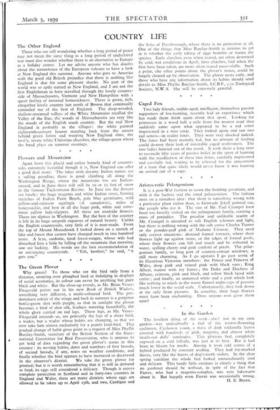Aristocratic Pelargonium
It is a post-War fashion to scorn the bedding geranium, and with it the fuchsia and the zonal pelargonium. The fashion rests on a mistaken idea : that there is something wrong with a particular plant rather than, as Gertrude Jekyll pointed out, the people who use it. The sins of Mr. Paul Crampel have been too heavily visited on the pelargonium family, creating a mass of prejudice. The peculiar and unlikable scarlet of Mr. Crampel is unsuited to soft English schemes and light, but there is nothing wrong with the soft cerise Charles Turner or the powder-puff pink of Madame Crousse. They need only correct situations: demand formal terraces, where their flowers light up against stone, or the edges of formal pools, where their flowers can fall and touch and he reflected in water, spilling cherry and pink confetti of petals. The pelar- gonium family, so long part of country-cottage windows, is still more charming. As I go upstairs I go past seven of its illustrious Victorian members: the Prince and Princess of Wales, deep pink and veined pink with black eyes ; King Albert, mauve with ivy leaves ; the Duke and Duchess of Albany, crimson, pink and black, and velvet black laced with cerise ; and finally, an unnamed white and a pink which look like nothing so much as the warm flannel night-caps of persons much lower in the social scale. Unfortunately, they look down at me only from pictures. In actuality, their huge flowers must have been enchanting. Does anyone ever grow them now?


























































 Previous page
Previous page